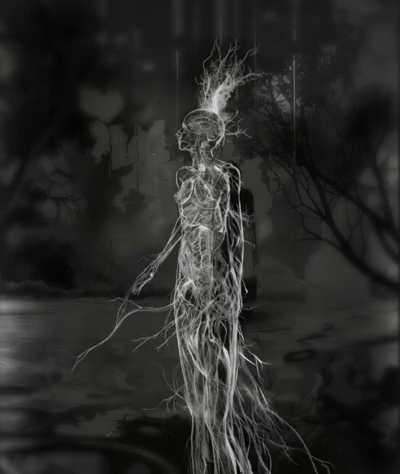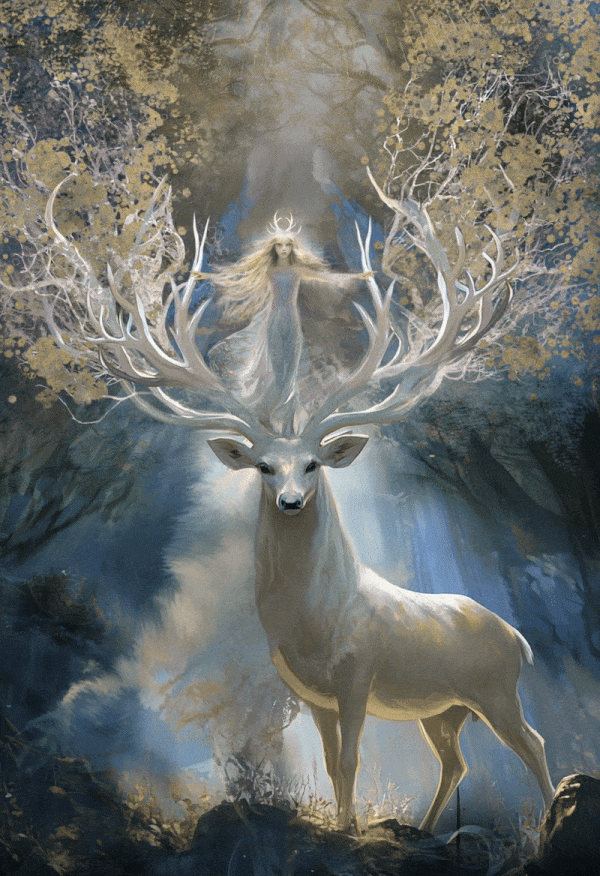My art involves many processes, integrating varied techniques, and like an alchemical transmutation can involve layers of evolution. Hence, with White Deer - Rites of Passage, what appears to be a simple fairy tale on the surface, has deeply rooted symbolism, within the concept, in the words, and the imagery.
Robert Graves published, The White Goddess in 1948. It is a book that blends poetry, mythology, and anthropology, calling forth a historical grammar of poetic myth rooted in Moon-goddess worship, a spiritual tradition he contends was at the heart of early European poetic culture.
My White Deer project—though told through a contemporary, visual, and symbolic narrative—embodies a similar impulse to reestablish a sacred connection between the evolution of self, and the soul’s journey. In both The White Goddess, and White Deer we encounter an ancient consciousness that centers on the primordial feminine—not only as a divine figure, but as a guiding principle of creativity, identity, and truth.
"One stepped forward, eyes ablaze
A divine mystery displayed
White as the snow that gently falls,
Its coat aglow, like moonbeams"
Ancient rites, rituals, and myths are encoded in the language of metaphor, paradox, and dream logic. The White Deer in my poem is not merely a creature of the forest, but a totemic presence—a living echo of the Moon-goddess that Graves so painstakingly uncovers. This ethereal being is not there to be captured or understood logically. Instead it represents a call for a more intuitive mode of engagement.
Graves argues that the original language of poetry was not ornamental but magical—ritualistic, performative, and alive with divine presence. This language, he suggests, was spoken in the ceremonies of goddess worship. The bards, the poets, and the priestesses of ancient rites did not write to entertain, but to invoke, to transform, to offer the soul back to itself.
"Bowing low in benediction
Its prayer revealed my afflictions
Opening these eyes to see
Fearless, is who I am to be"

White Deer channels this same sense of ritual and invocation. A coming of age girl is pulled into a vision of a mythic landscape where the ordinary laws of reality no longer apply. This “call of the wild,” is her invitation to cross over to adulthood. This crossing is not physical and psychological alone—it is spiritual, cosmic.
The enchanted forest, the other worldly specters, the dreamlike deer are visual metaphors that evoke the same primal mythic language essential to the Moon-goddess's rite.
At the heart of this journey lies a rite of passage—a transition between worlds, selves, or states of consciousness. The young female is chased by her imaginary future selves into the sanctuary of the White Deer clan. The known world is left behind to confront loss, transformation, and ultimately, integration. In The White Goddess, this process is mirrored in the bard’s ordeal—a journey through madness, exile, and ecstatic communion with the Muse. Graves emphasizes that this journey is not optional; it is the price of true inspiration, and it demands total surrender to the goddess.
The mythic feminine acts as initiator. She is not passive but directive; not nurturing in a maternal sense, but demanding and mysterious, calling the seeker into contact with life, death, and rebirth. This reflects Swiss Jungian analyst and scholar, Marie-Louise von Franz’ view of fairy tales, as concerned with the “rightness of action” and the abstract essence underlying reality. The White Deer leads us not to knowledge but to gnosis—not to answers, but to a deeper, symbolic ‘rightness’ with the cosmos.
"Courage and strength within me stirred
No longer a victim of destiny
I felt the surge of alchemy
A miracle, my body changed"
In Jungian terms, this rite of passage reflects an encounter with the Self—a concept Jung describes as “often symbolized as an animal,” especially in dreams. The White Deer, then, is more than mythic; it is the symbol of the Self, that archetypal core of the psyche that is “woven into the whole world, both outer and inner.” The appearance of this animal spirit marks the beginning of the integration of opposites, a union of masculine ego with feminine soul.

There is a disconnect between masculine rationality and feminine intuition that defines much of modern culture. Centuries of patriarchal shift replaced the Muse with Apollo, the living goddess with abstract logic.
There is much healing that is realized through the reintegration of the feminine. Poetry’s original purpose was to serve the Muse, to speak in the sacred tongue, to echo the rhythms of life.
The feminine here is archetypal, cosmic, and initiatory, not reduced to gender roles. The masculine hero must surrender not to a woman, but to feminine wisdom—to mystery, to nature, to spirit. This surrender is not weakness but strength, a reclaiming of a deeper, mythic masculinity in alignment with the sacred feminine.
"Human essence, animal lore
Revealed a truth forevermore
Immortal, full of grace am I
Fierce love with life’s battle cry"
Returning to the mythic, does not mean necessarily replicating ancient rituals, even though that could be powerfully effective. It means reawakening the sacred imagination—maps for the soul.
It is my experience that art in all its forms, like threads of insight and inspiration can help weave illumination for our transformational journeys. In White Deer - Rites of Passage there is an integration of many threads. Each thread reminds us that we are living, breathing myths of our own making.
"Now I stand, symbol of the wild
Girl and woman reconciled
Not only Goddess, do I see
I am Sovereign, Eternal, Free"
Bibliography
-
Graves, Robert. The White Goddess: A Historical Grammar of Poetic Myth. 1948.
-
von Franz, Marie-Louise. (1999). The Interpretation of Fairy Tales.
-
Jung, Carl. (1964). Man and His Symbols.

